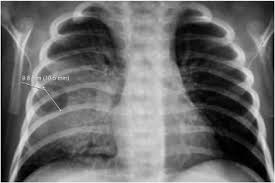 Congenital Cystic Adenomatoid Malformation (CCAM) is a rare developmental lung disorder that occurs during fetal development.
Congenital Cystic Adenomatoid Malformation (CCAM) is a rare developmental lung disorder that occurs during fetal development.
It results in an abnormal growth of lung tissue, which forms cyst-like structures within the lungs.
This condition is typically detected in utero, sometimes via ultrasound, and can affect one or both lungs.
CCAM occurs when there is abnormal growth of the lung’s airway structures during fetal development.
It is not usually inherited, and the exact cause is often unknown.
It’s a result of a disruption in the normal formation of the lungs during early pregnancy.
The malformation involves cystic air spaces and solid tissue within the affected lung, and can lead to impaired lung function.
CCAM is classified into four types based on the size and appearance of the cysts:
Type 1: Large cysts (2-10 cm) with a more well-defined, macrocystic appearance.
This type tends to have a better prognosis.
Type 2: Smaller cysts with a mixed cystic and solid pattern. It is more likely to be associated with other anomalies like kidney, heart, or skeletal issues, and can be more serious.
Type 3: Small, solid cysts without air-filled spaces.
This type is typically more severe and is associated with poor lung development and respiratory failure.
Type 4: Large cysts that often have a significant risk of causing lung collapse or fluid buildup.
3. Symptoms In the fetus, CCAM may be asymptomatic and found incidentally.
In severe cases, it can lead to complications, such as:
Hydrops fetalis
Respiratory distress after birth, if the condition is large or obstructive Infections if the cysts become infected.
After birth, symptoms can vary from mild to severe, depending on the size and location of the cystic growth. In severe cases, the baby may experience difficulty breathing and require immediate medical intervention.
The diagnosis is typically made prenatally via ultrasound and fetal MRI, which can show cystic structures within the lung.
Further testing after birth, such as chest X-rays and CT scans, can help assess the extent of the malformation.
The treatment for CCAM depends on the severity of the malformation:
Mild cases of CCAM, especially those with smaller cysts, may not require immediate intervention and may be monitored over time.
Surgery: In more severe cases, where there is significant respiratory distress or complications, surgical removal of the affected portion of the lung may is often necessary.
The procedure is typically done early in life, sometimes shortly after birth, depending on the severity of the condition.
Mild CCAM (Type 1): The prognosis is generally very good, with most babies recovering fully after surgery.
Moderate to Severe CCAM (Types 2 and 3): The prognosis depends on the size and extent of the cysts, as well as any associated abnormalities.
These may require more intensive treatment and monitoring.
Very severe cases (Type 4): If not treated promptly, CCAM can lead to severe complications, but with early intervention, many children can have normal or near-normal lung function.
